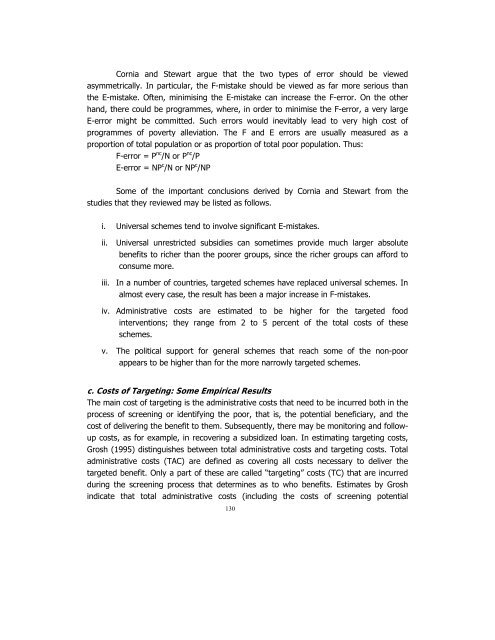POVERTY REDUCTION STRATEGY TN
Create successful ePaper yourself
Turn your PDF publications into a flip-book with our unique Google optimized e-Paper software.
Cornia and Stewart argue that the two types of error should be viewed<br />
asymmetrically. In particular, the F-mistake should be viewed as far more serious than<br />
the E-mistake. Often, minimising the E-mistake can increase the F-error. On the other<br />
hand, there could be programmes, where, in order to minimise the F-error, a very large<br />
E-error might be committed. Such errors would inevitably lead to very high cost of<br />
programmes of poverty alleviation. The F and E errors are usually measured as a<br />
proportion of total population or as proportion of total poor population. Thus:<br />
F-error = P nc /N or P nc /P<br />
E-error = NP c /N or NP c /NP<br />
Some of the important conclusions derived by Cornia and Stewart from the<br />
studies that they reviewed may be listed as follows.<br />
i. Universal schemes tend to involve significant E-mistakes.<br />
ii.<br />
Universal unrestricted subsidies can sometimes provide much larger absolute<br />
benefits to richer than the poorer groups, since the richer groups can afford to<br />
consume more.<br />
iii. In a number of countries, targeted schemes have replaced universal schemes. In<br />
almost every case, the result has been a major increase in F-mistakes.<br />
iv. Administrative costs are estimated to be higher for the targeted food<br />
interventions; they range from 2 to 5 percent of the total costs of these<br />
schemes.<br />
v. The political support for general schemes that reach some of the non-poor<br />
appears to be higher than for the more narrowly targeted schemes.<br />
c. Costs of Targeting: Some Empirical Results<br />
The main cost of targeting is the administrative costs that need to be incurred both in the<br />
process of screening or identifying the poor, that is, the potential beneficiary, and the<br />
cost of delivering the benefit to them. Subsequently, there may be monitoring and followup<br />
costs, as for example, in recovering a subsidized loan. In estimating targeting costs,<br />
Grosh (1995) distinguishes between total administrative costs and targeting costs. Total<br />
administrative costs (TAC) are defined as covering all costs necessary to deliver the<br />
targeted benefit. Only a part of these are called “targeting” costs (TC) that are incurred<br />
during the screening process that determines as to who benefits. Estimates by Grosh<br />
indicate that total administrative costs (including the costs of screening potential<br />
130

















